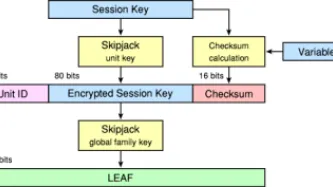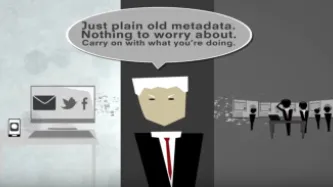Search
Content type: Examples
In 2014, researchers at Princeton University outlined an attack that uses multiple third-party cookies to link traffic so that individual users can be identified and tracked from anywhere in the world. A nation-state wishing to surveil particular users outside its jurisdiction, for example, may have access only to data that passes through routers within their country. Linking cookies and using only web page header data to track 25 simulated users browsing from a US location over a three-…
Content type: Examples
In 2017, a study claimed to have shown that artificial intelligence can infer sexual orientation from facial images, reviving the kinds of claims made in the 19th century about inferring character from outer appearance. Despite widespread complaints and criticisms, the study, by Michal Kosinski and Yilun Wang, is scheduled for publication in the respected Journal of Personality and Social Psychology. A reanalysis of the study's methodology and findings shows that the answers to a handful of yes…
Content type: Examples
In the remote western city Xinjiang, the Chinese government is using new technology and humans to monitor every aspect of citizens' lives. China, which has gradually increased restrictions in the region over the last ten years in response to unrest and violent attacks, blames the need for these measures on the region's 9 million Uighurs. This Muslim ethnic minority make up nearly half of the region's population, and the government accuses them of forming separatist groups and fuelling…
Content type: Examples
In May 2014 the Polish Ministry of Labor and Social Policy (MLSP) introduced a scoring system to distribute unemployment assistance. Citizens are divided into three categories by their “readiness” to work, the place they live, disabilities and other data. Assignment to a given category determines the type of labor market programs that a particular person can receive from the local labor offices (e.g. job placement, vocational training, apprenticeship, activation allowance). The Panoptykon…
Content type: Explainer
“Smart city” is a marketing term used to define the use of technology – and in particular data collection – to improve the functioning of cities. The idea behind smart cities is that the more local governments know about city inhabitants the better the services they deliver will be. However, the reality is that the term means different things to different actors from companies to governments.
The World Bank suggests two possible definitions of smart cities. The first one is “a technology-…
Content type: Examples
As part of its Smart Nation programme, in 2016 Singapore launched the most extensive collection of data on everyday living ever attempted in a city. The programme involved deploying myriad sensors and cameras across the city-state to comprehensively monitor people, places, and things, including all locally registered vehicles. The platform into which all this data will be fed, Virtual Singapore, will give the government the ability to watch the country's functioning in real time. The government…
Content type: Examples
In 2016, Nguyen Phong Hoang, a security researcher in Kyoto, Japan demonstrated that the location of users of gay dating apps such as Grindr, Hornet, and Jack'd can be pinpointed even when they have turned on features intended to obscure it - a dangerous problem for those have not come out publicly as LGBT or who live in a hostile location. The technique is known as trilateration and relies on the fact that these apps display images of nearby users in order of proximity. That ordering…
Content type: Examples
A new generation of technology has given local law enforcement officers in some parts of the US unprecedented power to peer into the lives of citizens. In Fresno, California, the police department's $600,000 Real Time Crime Center is providing a model for other such centres that have opened in New York, Houston, and Seattle over the decade between 2006 and 2016. The group of technologies used in these centres includes ShotSpotter, which uses microphones around the city to triangulate the…
Content type: Examples
Automated systems such as the personality test developed by Massachusetts-based workforce management company Kronos are increasingly used by large companies to screen job applicants. To avoid falling foul of regulations prohibiting discrimination against those with mental illness, often the questions are phrased in intricate ways that are harder to game - but also harder to answer without self-incrimination. It's estimated that as many as 72% of CVs are never seen by human eyes; instead, they…
Content type: Examples
In September 2016, the US Federal Trade Commission hosted a workshop to study the impact of big data analysis on poor people, whose efforts to escape poverty may be hindered by the extensive amounts of data being gathered about them. Among those who intensively surveil low-income communities are police, public benefits programmes, child welfare systems, and monitoring programmes for domestic abuse offenders. Some areas require applicants for food stamps and other public benefits to undergo…
Content type: Examples
In a 2017 study of patterns of postings on Chinese social media, three Harvard researchers disagreed with the widespread claim that the government's strategy is to post "50c party" posts that argue for the government's side in policy and political debates. Instead, the researchers estimated that the Chinese government fabricates as many as 448 million social media comments a year but found that these avoid controversial issues and arguments with government skeptics. Instead, the researchers…
Content type: Examples
In the 2014 report "Networked Employment Discrimination", the Future of Work Project studied data-driven hiring systems, which often rely on data prospective employees have no idea may be used, such as the results of Google searches, and other stray personal data scattered online. In addition, digital recruiting systems that only accept online input exclude those who do not have internet access at home and must rely on libraries and other places with limited access and hours to fill in and…
Content type: Examples
Because banks often decline to give loans to those whose "thin" credit histories make it hard to assess the associated risk, in 2015 some financial technology startups began looking at the possibility of instead performing such assessments by using metadata collected by mobile phones or logged from internet activity. The algorithm under development by Brown University economist Daniel Björkegren for the credit-scoring company Enterpreneurial Finance Lab was built by examining the phone records…
Content type: Examples
In 2016, the American Civil Liberties Union of Northern California published a report revealing that the social media monitoring service Geofeedia had suggested it could help police track protesters. The report's publication led Twitter and Facebook to restrict Geofeedia's access to their bulk data. ACLUNC argued that even though the data is public, using it for police surveillance is an invasion of privacy. Police are not legally required to get a warrant before searching public data; however…
Content type: Examples
Documents submitted as part of a 2015 US National Labor Relations Board investigation show that Walmart, long known to be hostile to unions, spied on and retaliated against a group of employees who sought higher wages, more full-time jobs, and predictable schedules. In combating the group, who called themselves the Organization United for Respect at Walmart (OUR Walmart), Walmart hired an intelligence-gathering service from Lockheed Martin, contacted the FBI, and set up an internal Delta team…
Content type: Examples
At the Sixth Annual Conference on Social Media Within the Defence and Military Sector, held in London in 2016, senior military and intelligence officials made it clear that governments increasingly view social media as a tool for the Armed Forces and a "new front in warfare". Social media are also viewed as a source of intelligence on civilian populations and enemies and as a vector for propaganda. The conference was sponsored by Thales, which was working with the National Research Council of…
Content type: Examples
As GPS began being increasingly incorporated into smartphones, satnav manufacturers like the Dutch company TomTom were forced to search for new revenue streams. In 2011, TomTom was forced to apologise when the Dutch newspaper AD reported that the company had sold driving data collected from customers to police, which used it to site speed cameras in locations where speeding was common. TomTom said that any information it shares had been anonymised; however, in response to the newspaper story…
Content type: Examples
In 2014, India's newly elected prime minister, Narendra Modi, allocated INR70.6 billion (upwards of £750 million) to a plan called "100 Smart Cities". Although a year later the funding dropped to INR1.4 billion, smart city-themed conference continued to take place in Delhi and Mumbai, and urban development minister Venkaiah Naidu expected imminent roll-out of cities with infrastructure comparable to any developed European city. However, the earliest of these cities - such as Palava City, built…
Content type: Examples
In 2015, The Intercept obtained documents showing that the Mall of America in Bloomington, Minnesota used a fake Facebook account to friend and monitor local Black Lives Matter activists, and collect their personal information and photographs without their knowledge. The account was discovered in a cache of files the Mall of America provided to Bloomington officials after a large BLM protest against police brutality that was held at the mall. After the protest, the city charged 11 protesters…
Content type: Examples
Twitter requested one of its key B2B partners, Dataminr — a service that offers advanced social media analytics and early detection of major events like terrorist attacks or natural disasters — stop providing U.S. intelligence agencies with their tools and content. Dataminr isn’t ending its relationship with the government altogether: Dataminir still counts In-Q-Tel, the non-profit investment arm of the CIA, as an investor. Dataminr has taken investment from Twitter, too, highlighting some of…
Content type: Examples
According to the US security firm Statfor the Chinese government has been builsing a system to analyse the massive amounts of data it has been collecting over the past years. The company claims: "The new grid management system aims to help the Chinese government act early to contain social unrest. Under the new program, grid administrators each monitor a number of households (sometimes as many as 200). They then aggregate their reports into one enormous surveillance database, where it is…
Content type: Examples
A new examination of documents detailing the US National Security Agency's SKYNET programme shows that SKYNET carries out mass surveillance of Pakistan's mobile phone network and then uses a machine learning algorithm to score each of its 55 million users to rate their likelihood of being a terrorist. The documents were released as part of the Edward Snowden cache. The data scientist Patrick Ball, director of research at the Human Rights Data Analysis Group, which produces scientifically…
Content type: Examples
In 2016 the Dutch Data Protection Authority (AP) ruled that the Personal Data Protection Act prohibits companies from monitoring their employees' health via wearables, even when employees have given their permission. The ruling concluded the AP's investigation into two companies; in one of them, wearables even gave the employer insight into its employees' sleep patterns. The AP argued that employers are free to give wearables as gifts, but that the power relationship between employer and…
Content type: Impact Case Study
PI and our global partners have been at the forefront of challenging communications data retention for over a decade.
What is the problem
Communications data, also known as metadata, tells a story about your digital activity and answers the who, when, what, and how of a specific communication. While communications data doesn't include the contents of a message, all of the other information about the message can be very revealing about people, their habits, thoughts, health and personal…
Content type: Impact Case Study
What happenedThe Clinton Administration kicked off the cypto-wars in 1993 with the Clipper Chip. The continued application of export controls restrained the deployment of strong cryptography in products at a key moment of internet history: as it began to be embedded in software and networking. What we didIn the early phases of the crypto-wars we placed pressure on global industry to implement encryption in their products. We ran campaigns and events across the world on the need for strong…
Content type: Impact Case Study
What is the problem
For over two decades we have been documenting an alarming use and spread of surveillance. It is no longer just the wars on terror or drugs or migration that is driving this trend. The management of health crises and distribution of welfare regularly are among others being used to justify this turn to increasingly invasive forms of surveillance. From country to country we see the same ideas and the same profiteers expanding their reach.
When we first released our report on…
Content type: Impact Case Study
What is the problem
Business models of lots of companies is based on data exploitation. Big Tech companies such Google, Amazon, Facebook; data brokers; online services; apps and many others collect, use and share huge amounts of data about us, frequently without our explicit consent of knowledge. Using implicit attributes of low-cost devices, their ‘free’ services or apps and other sources, they create unmatched tracking and targeting capabilities which are being used against us.
Why it is…
Content type: Impact Case Study
What happenedIn the aftermath of 9/11, Governments across the world rushed to legislate to expand surveillance. GovernmentsMoved to limit debate and reduce consultations as they legislated with speed.Created new systems to collect data on all travellers, for the purpose of profiling and risk scoring.Expanded identity schemes, and began demanding biometrics, particularly at borders.Developed financial surveillance mechanisms on an unprecedented scale.What we didFew non-governmental…
Content type: Impact Case Study
What happenedGovernments continuously seek to expand their communications surveillance powers. In the 1990s it was in the context of applying telephone surveillance laws to the internet. In the 2000s a spate of new laws arrived in response to 9/11. Expansions were then sought to monitor over-the-top services within the framing of Web 2.0. Then in the post-Snowden environment Governments rushed to legislate their previously secret powers.What we didWe supported…
Content type: Impact Case Study
What happenedUnder pressure to be more accountable for their use of resources, but also due to the post-9/11 push to track and identify terrorists across the world, the humanitarian and development sectors began increasingly to look to identity registration, including biometrics, and the collection and sharing of vast amounts of data on their beneficiaries. Development funding was supporting the deployment of ID systems, and both sectors were enthralled with ‘big data’ initiatives, all…




























